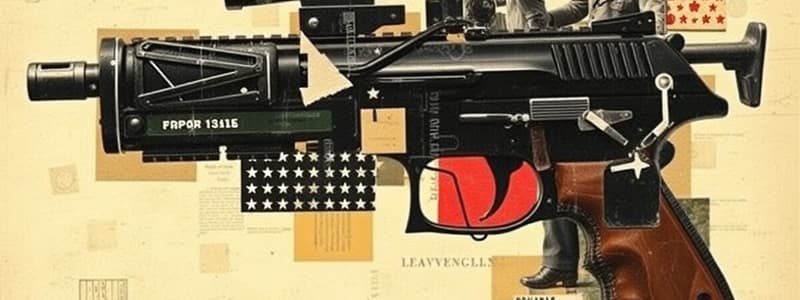Podcast
Questions and Answers
Which of the following target areas is considered deadly force when struck with an impact weapon?
Which of the following target areas is considered deadly force when struck with an impact weapon?
- Outside of Thigh
- Top of Calf
- Side of Neck (correct)
- Inside of Forearm
What is a common technique used with impact weapons?
What is a common technique used with impact weapons?
- Throwing
- Stabbing
- Flipping
- Thrusting (correct)
What is the primary motion used when performing an impact weapon swing?
What is the primary motion used when performing an impact weapon swing?
- Circular motion (correct)
- Back and forth
- Diagonal motion
- Straight line
In executing an impact weapon thrust, what should be utilized throughout the technique?
In executing an impact weapon thrust, what should be utilized throughout the technique?
What is the purpose of a block when using an impact weapon?
What is the purpose of a block when using an impact weapon?
Which areas are safe to strike with an impact weapon without the risk of being classified as deadly force?
Which areas are safe to strike with an impact weapon without the risk of being classified as deadly force?
When performing an impact weapon swing, which part of the weapon can be utilized?
When performing an impact weapon swing, which part of the weapon can be utilized?
What action is necessary after employing an impact weapon thrust?
What action is necessary after employing an impact weapon thrust?
What is the primary purpose of intermediate weapons?
What is the primary purpose of intermediate weapons?
Which of the following is NOT considered an impact weapon?
Which of the following is NOT considered an impact weapon?
In what stance should an officer hold an impact weapon for an offensive ready position?
In what stance should an officer hold an impact weapon for an offensive ready position?
What is one role of an impact weapon beyond physical strikes?
What is one role of an impact weapon beyond physical strikes?
Which of the following is an example of a 'weapon of opportunity'?
Which of the following is an example of a 'weapon of opportunity'?
Which target area is considered most vulnerable to impact weapon strikes?
Which target area is considered most vulnerable to impact weapon strikes?
What type of control do intermediate weapons primarily provide?
What type of control do intermediate weapons primarily provide?
Why is the baton still commonly used despite new weapon developments?
Why is the baton still commonly used despite new weapon developments?
Flashcards
Intermediate Weapons
Intermediate Weapons
Tools used when empty-hand control is ineffective, but the subject's resistance doesn't warrant deadly force.
Impact Weapon
Impact Weapon
Any object used for striking; may disable or cause temporary motor dysfunction.
Baton
Baton
Common impact weapon; standard tool used by some agencies.
Weapon of Opportunity
Weapon of Opportunity
Signup and view all the flashcards
Interview Stance (Impact Weapon)
Interview Stance (Impact Weapon)
Signup and view all the flashcards
Offensive Ready Stance (Impact Weapon)
Offensive Ready Stance (Impact Weapon)
Signup and view all the flashcards
Target Areas (Impact Weapons)
Target Areas (Impact Weapons)
Signup and view all the flashcards
Non-Deadly Force (NDF)
Non-Deadly Force (NDF)
Signup and view all the flashcards
Impact Weapon Thrust
Impact Weapon Thrust
Signup and view all the flashcards
Impact Weapon Swing
Impact Weapon Swing
Signup and view all the flashcards
Impact Weapon Block
Impact Weapon Block
Signup and view all the flashcards
Deadly Force Target - Head
Deadly Force Target - Head
Signup and view all the flashcards
Deadly Force Target - Throat
Deadly Force Target - Throat
Signup and view all the flashcards
Deadly Force Target - Groin
Deadly Force Target - Groin
Signup and view all the flashcards
Impact Weapon Target - Forearm (NDF)
Impact Weapon Target - Forearm (NDF)
Signup and view all the flashcards
Impact Weapon Target - Abdomen (NDF)
Impact Weapon Target - Abdomen (NDF)
Signup and view all the flashcards
Study Notes
Intermediate Weapons
- Intermediate weapons are used when empty-hand control fails but deadly force isn't warranted.
- These weapons cause potential great bodily harm but are not designed for lethal force.
- Impact weapons affect subjects psychologically through the demonstration of officer skill and authority.
Types of Intermediate Weapons
- Impact Weapons: Batons, weapons of opportunity (e.g., broomsticks, flashlights), beanbag rounds, baton rounds (plastic/rubber bullets).
- Specialty Impact Weapons: Beanbag rounds (lead shot with fabric cover) fired from a shotgun; baton rounds (plastic/rubber bullets).
- Electronic Control Devices: Conducted electrical weapons (CEWs)
- Chemical Agents
Impact Weapons
- Impact weapons are used for striking.
- Batons remain a standard tool for some law enforcement agencies.
- Other weapons of opportunity include items like broomsticks, flashlights, clipboards, and radios.
Stances with Impact Weapons
- Interview Stance: Low-profile stance with the weapon partially hidden behind the leg.
- Offensive Ready Stance: High-profile stance with the weapon held at the shoulder for a quick strike.
Target Areas for Impact Weapon Strikes
- Non-deadly Force (NDF): Strikes to the front of the shoulder, top of forearm, inside of forearm, outside of thigh, inside of thigh, center of abdomen, and top of calf. NDF strikes aim to disable or cause temporary motor dysfunction.
- Deadly Force (DF): Strikes to the side of the neck, head, throat, groin. DF strikes will have deadly effects when used.
Impact Weapon Techniques
- Thrusts: Straight-line movements with the tip, back, or shaft of the impact weapon.
- Swings: Circular motions utilizing shaft/edge of the weapon.
- Blocks: Positioning weapon between the officer and the subject to defend against attack.
- Scan blocks pull across the body.
- Power blocks push against the attacking arm.
Electronic Control Devices (ECDs)
- These devices use high voltage, low power electricity to induce involuntary muscle contractions.
- They are designed for nonlethal use and are considered safe on people.
- ECDs can cause extreme muscular tension and temporary balance/coordination issues.
- Types include conducted electrical weapons (CEWs), handheld stun guns, electronic shields, electronic belts, electronic sleeves.
Studying That Suits You
Use AI to generate personalized quizzes and flashcards to suit your learning preferences.




